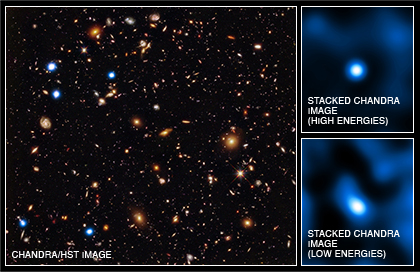For Release: June 15, 2011
NASA
Correction: After this paper (Treister et al. 2011) was published and publicized a problem was discovered with the background subtraction used. Analysis by several groups, including the Treister et al. team, plus Willott (2011) and Cowie et al. (2012), shows that a significant detection of AGN (growing black holes) in the early universe can no longer be claimed.
Editor's Note: Honest errors such as this are part of the scientific process, especially on the frontiers of discovery. To quote Nobel laureate Frank Wilczek, "If you don't make mistakes, you're not working on hard enough problems. And that's a big mistake."
References:
Cowie, L. et al. 2012, ApJ, in press
http://lanl.arxiv.org/abs/1110.3326
Treister, E. et al. 2011, Nature, 474, 356
http://lanl.arxiv.org/abs/1106.3079
Willott, C. 2011, ApJ, 742, L8
http://lanl.arxiv.org/abs/1110.4118

Credit: X-ray: NASA/CXC/U.Hawaii/E.Treister et al; Infrared: NASA/STScI/UC Santa Cruz/G.Illingworth et al; Optical: NASA/STScI/S.Beckwith et al
Press Image and Caption
WASHINGTON -- Using the deepest X-ray image ever taken, astronomers found the first direct evidence that massive black holes were common in the early universe. This discovery from NASA's Chandra X-ray Observatory shows that very young black holes grew more aggressively than previously thought, in tandem with the growth of their host galaxies.
By pointing Chandra at a patch of sky for more than six weeks, astronomers obtained what is known as the Chandra Deep Field South (CDFS). When combined with very deep optical and infrared images from NASA's Hubble Space Telescope, the new Chandra data allowed astronomers to search for black holes in 200 distant galaxies, from when the universe was between about 800 million to 950 million years old.

From left are: Trent Perroto, NASA Public Affairs Officer; Wilt Sanders, Chandra Program Scientist at NASA Headquarters; Ezequiel Treister, astrophysicist, Institute for Astronomy at the University of Hawaii at Manoa; Kevin Schawinski, astrophysicist, Yale University; Priyamvada Natarajan, astrophysicist, Yale University and Mitch Begelman, Professor, Department of Astrophysical and Planetary Sciences, University of Colorado Boulder. Photo Credit: (NASA/Carla Cioffi)
"Until now, we had no idea what the black holes in these early galaxies were doing, or if they even existed," said Ezequiel Treister of the University of Hawaii, lead author of the study appearing in the June 16 issue of the journal Nature. "Now we know they are there, and they are growing like gangbusters."
The super-sized growth means that the black holes in the CDFS are less extreme versions of quasars -- very luminous, rare objects powered by material falling onto supermassive black holes. However, the sources in the CDFS are about a hundred times fainter and the black holes are about a thousand times less massive than the ones in quasars.
The observations found that between 30 and 100 percent of the distant galaxies contain growing supermassive black holes. Extrapolating these results from the small observed field to the full sky, there are at least 30 million supermassive black holes in the early universe. This is a factor of 10,000 larger than the estimated number of quasars in the early universe.
"It appears we've found a whole new population of baby black holes," said co-author Kevin Schawinski of Yale University. "We think these babies will grow by a factor of about a hundred or a thousand, eventually becoming like the giant black holes we see today almost 13 billion years later."
A population of young black holes in the early universe had been predicted, but not yet observed. Detailed calculations show that the total amount of black hole growth observed by this team is about a hundred times higher than recent estimates.
Because these black holes are nearly all enshrouded in thick clouds of gas and dust, optical telescopes frequently cannot detect them. However, the high energies of X-ray light can penetrate these veils, allowing the black holes inside to be studied.
Physicists studying black holes want to know more how the first supermassive black holes were formed and how they grow. Although evidence for parallel growth of black holes and galaxies has been established at closer distances, the new Chandra results show that this connection starts earlier than previously thought, perhaps right from the origin of both.
"Most astronomers think in the present-day universe, black holes and galaxies are somehow symbiotic in how they grow," said Priya Natarajan, a co-author from Yale University. "We have shown that this codependent relationship has existed from very early times."
It has been suggested that early black holes would play an important role in clearing away the cosmic "fog" of neutral, or uncharged, hydrogen that pervaded the early universe when temperatures cooled down after the Big Bang. However, the Chandra study shows that blankets of dust and gas stop ultraviolet radiation generated by the black holes from traveling outwards to perform this "reionization." Therefore, stars and not growing black holes are likely to have cleared this fog at cosmic dawn.

